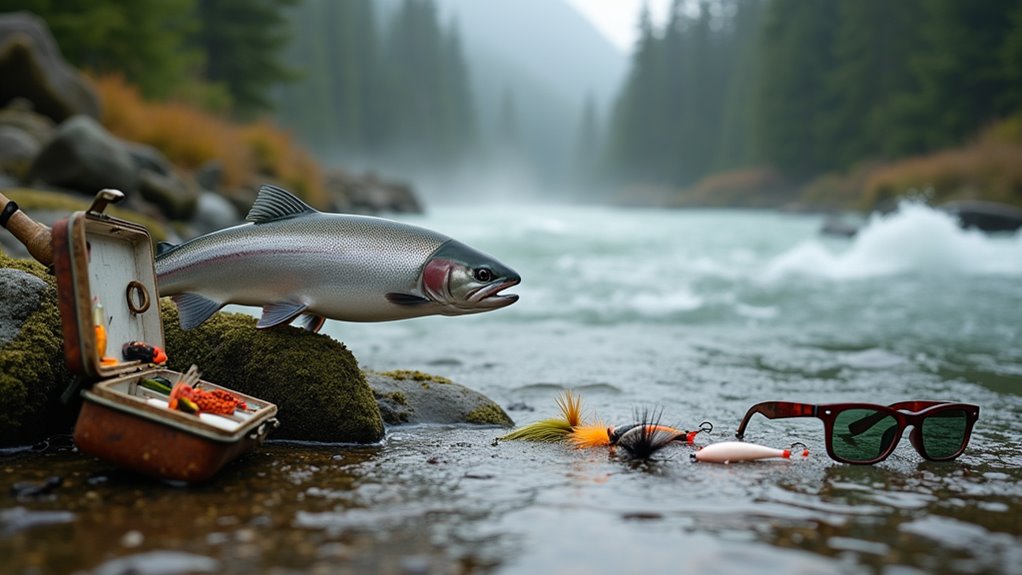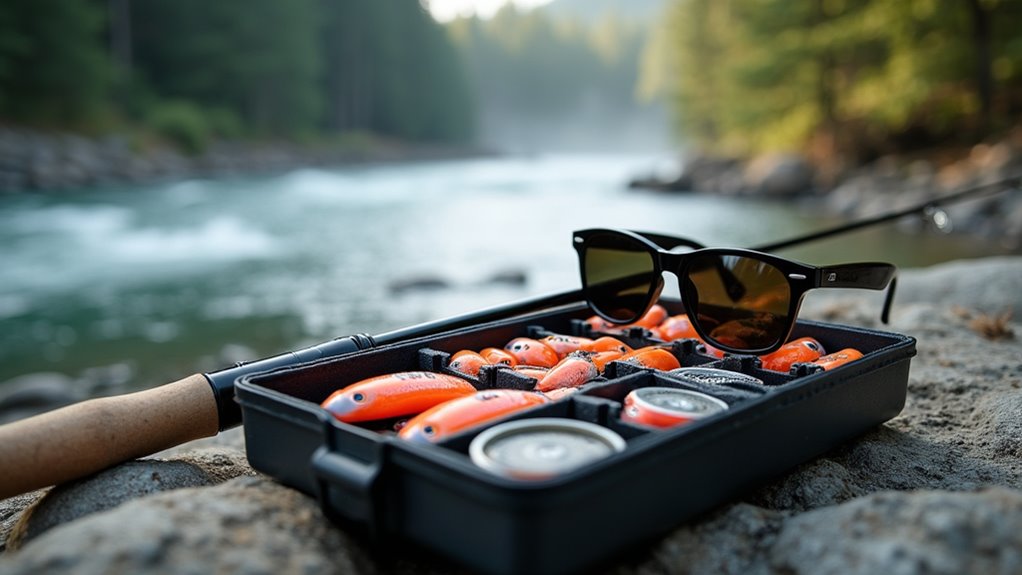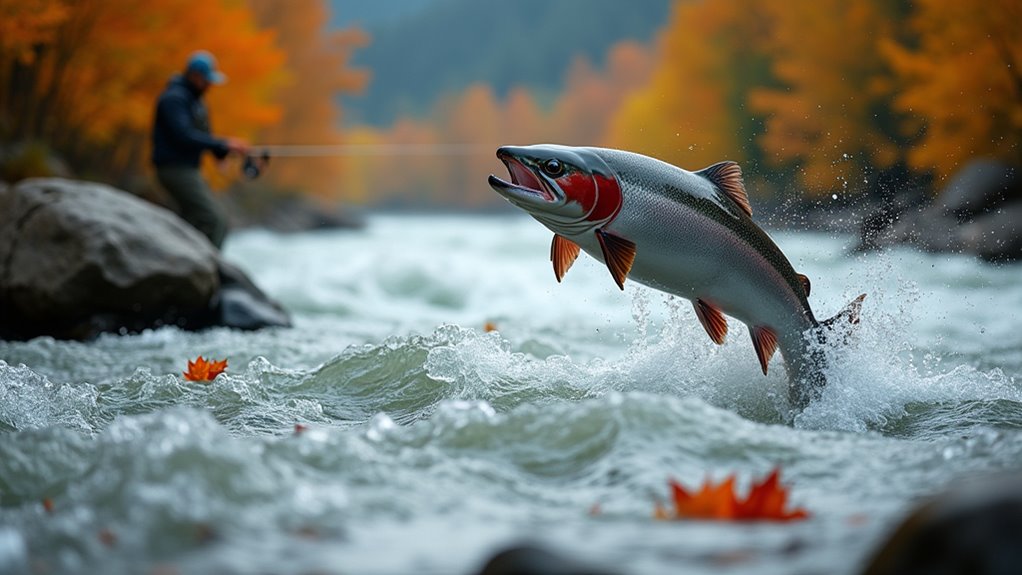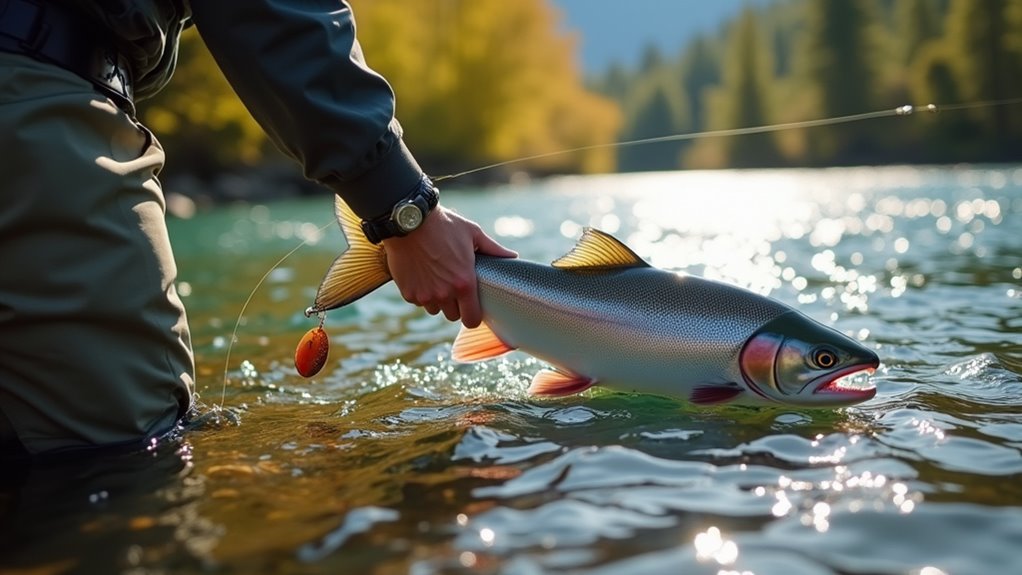Physical Address
304 North Cardinal St.
Dorchester Center, MA 02124
Physical Address
304 North Cardinal St.
Dorchester Center, MA 02124

Catch more salmon with these 6 crucial techniques that experienced anglers use to consistently outfish everyone else on the water.
You’ve probably experienced the frustration of watching salmon swim past your line while other anglers nearby reel in fish after fish. The difference isn’t luck—it’s knowledge. Successful salmon fishing requires mastering six essential techniques that separate beginners from seasoned pros. These proven strategies will transform your fishing trips from hopeful casting sessions into productive adventures. Once you understand these fundamentals, you’ll wonder why you ever struggled to hook these magnificent fish.

When you’re targeting salmon, your success depends heavily on matching your gear to the specific species you’re after. King salmon require heavy-duty equipment—think 8-10 weight rods with strong reels that can handle 20-30 pound fish.
King salmon demand serious gear—heavy 8-10 weight rods and reels built to battle 20-30 pound fish.
For coho and pink salmon, you’ll get away with lighter 6-8 weight setups.
Your tackle selection matters just as much. Use larger flies or lures for kings, while smaller presentations work better for other species.
Don’t forget your line choice—floating lines for surface action, sinking lines for deeper water.
Sharp hooks are non-negotiable since salmon have tough mouths.
Finally, bring a quality landing net and pliers. You’ll need them when that salmon decides to make its run.
Just like scuba divers face common challenges when exploring underwater environments, salmon anglers must prepare for various obstacles and equipment failures during their fishing adventures.
Since salmon behavior follows predictable patterns throughout their lifecycle, you’ll dramatically increase your catch rate by learning to identify where they’re most likely to be holding. Look for current breaks where fast water meets slower zones – salmon rest in these calmer pockets while maintaining access to the main flow.
Deep pools below rapids and waterfalls are prime spots, as exhausted fish recover before continuing upstream.
Focus on structure like submerged rocks, fallen trees, and undercut banks that provide cover and ambush points. Early morning and evening hours are most productive when salmon move actively.
Pay attention to water temperature – salmon prefer cooler zones, often found near tributary mouths or spring seeps. Watch for jumping fish, which indicates active salmon in the area.
Just as mountain climbers must avoid deadly mistakes that could compromise their safety, salmon anglers need to recognize common errors that lead to unsuccessful fishing trips.

Understanding salmon migration patterns transforms your fishing success from random luck into strategic precision. You’ll dramatically increase your catch rates by timing trips with nature’s schedule.
Spring runs typically peak between April and June when salmon enter rivers for spawning. Target early morning hours when water temperatures are cooler and fish are most active.
April through June offers prime salmon fishing as spawning runs begin—hit the water early when cool temperatures trigger peak activity.
Summer fishing works best in deeper, cooler waters as salmon seek thermal refuges.
Fall brings the most productive fishing opportunities. September through November sees massive salmon runs heading upstream, making them aggressive and easier to catch. Monitor local fish counts and water temperatures—salmon move when conditions align.
Winter fishing requires patience but rewards persistent angelers. Focus on slower presentations in deeper pools where salmon conserve energy during colder months. Even experienced anglers can fall into common fishing mistakes that reduce their success rates during these crucial migration periods.
Although salmon species vary by region, choosing the right lure or bait makes the difference between an empty cooler and a successful day on the water. You’ll want to match your selection to local salmon preferences and current conditions.
Spoons work exceptionally well for Chinook and Coho salmon, particularly silver or gold varieties that mimic baitfish. Spinner baits create vibrations that attract salmon in murky water, while plugs excel in deeper runs.
For natural bait, salmon eggs remain the gold standard – they’re irresistible to most species.
Don’t overlook herring, sardines, or shrimp when targeting saltwater salmon. In rivers, try worms or salmon roe.
Research your specific fishing location beforehand, as regional preferences vary considerably. Local tackle shops provide invaluable insight into what’s currently producing results. Many fly fishing enthusiasts also find success with streamer patterns that imitate small fish when targeting salmon in rivers and streams.

Once you’ve selected the right lure or bait, your presentation becomes the critical factor that triggers a salmon’s strike response. Vary your retrieval speed constantly – salmon often strike during speed changes rather than steady retrieves. Start with slow, steady pulls, then add sudden jerks or pauses to mimic injured baitfish.
Keep your lure in the strike zone longer by counting down before retrieving. In deeper water, let spoons flutter down while maintaining slight tension. For spinners, retrieve just fast enough to feel the blade’s vibration.
Pay attention to your rod tip – subtle taps often indicate strikes. Set the hook immediately with a firm upward sweep.
When trolling, maintain proper speed and depth while watching your downrigger or fish finder for salmon activity. Just like avoiding common mistakes when making any significant purchase, successful salmon fishing requires careful preparation and avoiding typical presentation errors that can cost you the catch.
When you feel that electric pull on your line, resist the urge to horse the fish in quickly – salmon are powerful fighters that’ll snap your line or tear free if you’re too aggressive. Keep your rod tip up at a 45-degree angle to maintain constant pressure while absorbing their runs. Let your drag system do the work, allowing the fish to take line when it surges away from you.
When the salmon jumps, bow your rod toward it to create slack and prevent line breakage. Stay patient during long runs – tired fish are easier to land. Once you’ve brought the salmon close, use a landing net or beach it in shallow water. Always wet your hands before handling to protect their slime coat if you’re releasing.
Many senior anglers find that taking frequent breaks during long fights helps maintain focus and prevents fatigue that could cost you the catch.
You’ll become an absolute salmon-catching machine once you’ve mastered these six essential tips. Remember, success isn’t just about luck—it’s about preparation, timing, and technique working together. Don’t get discouraged if you don’t land a trophy on your first trip; even experienced anglers face challenging days on the water. Keep practicing these fundamentals, stay patient, and you’ll soon be bringing home those beautiful salmon you’ve been dreaming about.